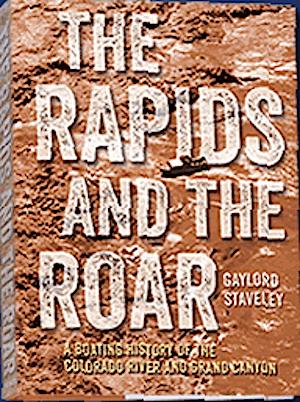At first glance, this looks like just another book about rafting in the Grand Canyon and its rapids. It can be, after all, a life-changing experience and people just want feel compelled to write about it. But Gaylord Stavely was not only one of the first people to raft the river; he was there when the entire river-running industry was born, knows all of the history behind the places, and the eccentric people who yearned for the freedom of the river. There's 60 years of fascinating reading here.
As a long-time canyon visitor and rafter, I learned a lot that I didn't know, including some very obscure events. For instance: how did the boaters negotiate their passage through the Glen Canyon dam site when it was under construction, to avoid being hit by the rocks the high-scalers were peeling off of the sandstone walls? Staveley describes in detail the delicate dance between the dam builders and the boaters. He writes of his dreams of an economic boom with the new reservoir, begrudgingly perhaps, but he foresaw a tourist destination, and a way to make for him to make a living in this hardscrabble desert.
Even though I spent some time on an air mattress in the Lower Canyon, I'd never heard of the River Trotter. This was a seven-foot Plexiglas sphere that adventurer Wayne Wilson wanted to ride down the Grand Canyon, but settled for San Juan River, walking inside of the contraption for propulsion. It's an interesting sideshow in a grand progression of watercraft from Powell to the Kolb brothers to the Nevills.
Staveley also gives great insight to what it was like to thrive in the barren desert with his family in Mexican Hat, where, he said they would "dig for wood, and climb for water." Borne here, as well, were lifelong friendships and personal clashes from competitive boat companies.
He describes the huge snowmelt-fed flows on the river, and other the times when there was nearly no water in the Canyon, and they had to drag their wooden cataract boats through the mud and rocks. They usually portaged or lined their wooden boats around Hance Rapid (a long, violent, rock-studded rapid which is one of the few in the canyon created by a giant stone dike, and not side-canyon flooding). Today Hance is still a thrill, but things have changes with today's boats: it's more of a pinball ride on big rubber pontoons now.
The book is studded with a wild cast of canyon characters; from river rats like Georgie White who barreled through the canyon fueled with beer and a bikini top in the 1960s, to singer Katie Lee who found the freedom from civilization she craved, to boatman Martin Litton's intensity with his wooden dories. In the Canon there are smashed boats, ghosts, unidentified headless skeletons, and more stories than one person should rightly know, or remember, and most of them probably true in this book.
A few months ago when I attended a memorial for an old boatman buddy, Art Gallenson, at Lees Ferry (his ashes were placed in a small wooden replica of Powell's boat the Emma Dean and sent on their final journey through the canyon) I was struck by just how damn old everyone was there. But a half dozen decades ago these were truly iron men (and women) in wooden boats who discovered the thrill and solace found in deserts and on rivers. Staveley would eventually create the river-running company Canyoneers which introduced thousands of visitors to his stomping grounds. Thank goodness he wrote all of this stuff down.




Add comment